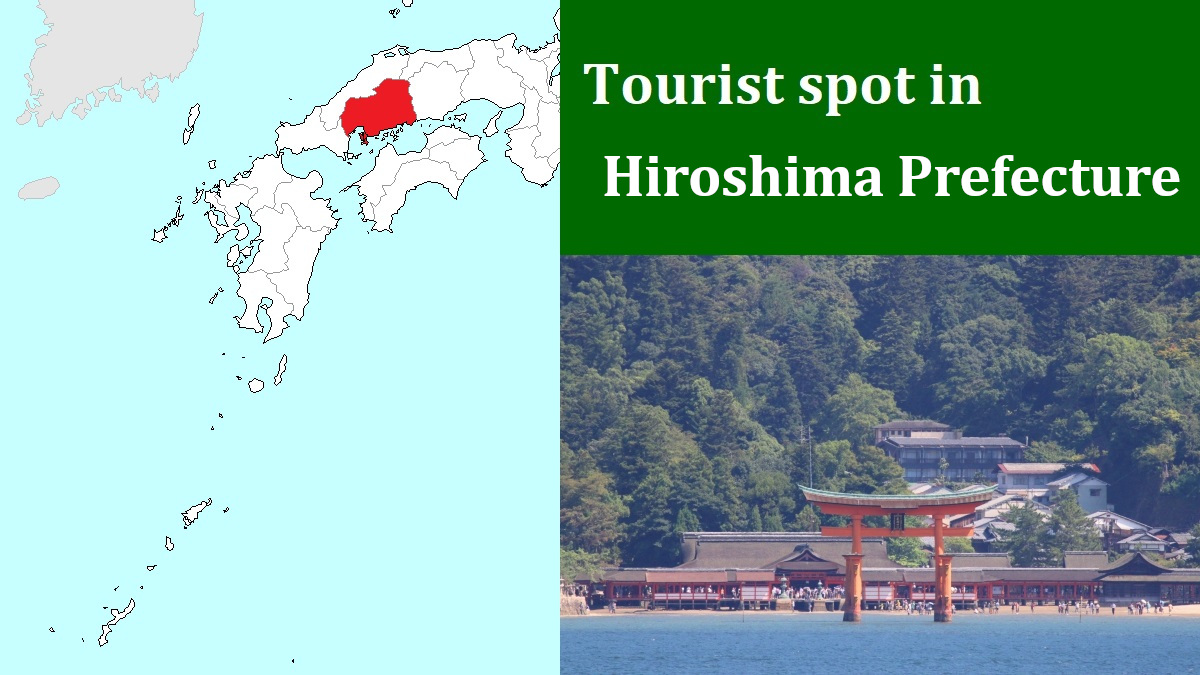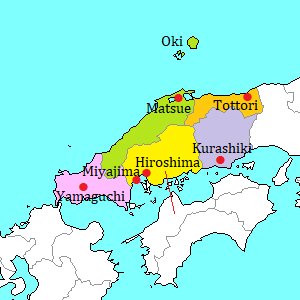Itsukushima Shrine (Miyajima) [厳島神社 (宮島)]
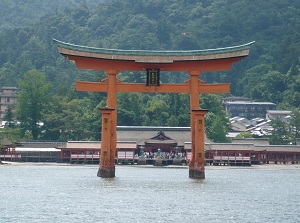
Itsukushima Shrine
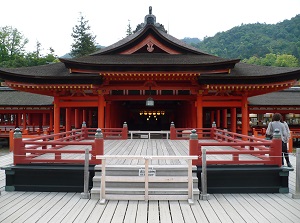
Main shrine of Itsukushima Shrine
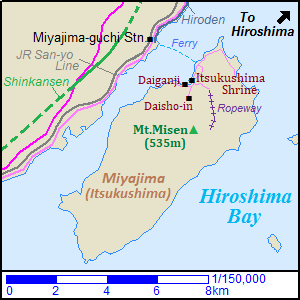
Itsukushima Shrine is a Shinto shrine in Itsukushima island.
Itsukushima is the formal name, and the popular name is Miyajima.
Miyajima island is in the west part of Hiroshima Bay, and is located about 20 km southwest of Hiroshima city.
The island is about 10 km long and about 4 km wide, and there is a narrow channel within 2 km wide between the long northwest coast and the mainland.
Itsukushima Shrine is located on the northern coast.
Since ancient times, Miyajima had been worshipped as a god.
It is said that the original shrine was built in this island in 593.
Around 1168, the current unique and gorgeous shrine was built by Taira Kiyomori (1118-1181), a strong warlord.
In the 1560s, Môri Motonari (1497-1571), a good ruler in Hiroshima area, repaired this shrine on a large scale.
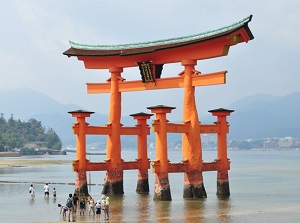
Otorii of Itsukushima Shrine
Photo by Railstation.net
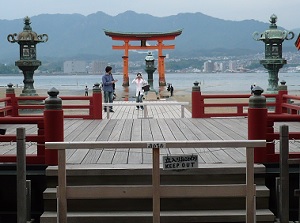
Otorii from main shrine
Photo by Railstation.net
This shrine features the wooden buildings on the sea.
The place of this shrine is in a cove with a great tidal range.
There is Ôtorii (大鳥居, Great Torii Gate) about 16 meters high at the entrance of the cove.
It is a wooden construction in the sea.
So it has been rebuilt eight times for about 1,400 years.
The current Ôtorii was rebuilt in 1875.
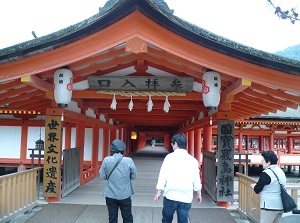
Entrance gate of Itsukushima Shrine
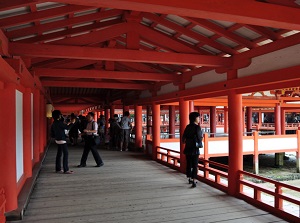
Corridor of Itsukushima Shrine
Photo by Railstation.net
There is the main shrine at about 200 meters back of Ôtorii.
The entrance of the main shrine is on the seaside, and we can reach the main shrine by walking on the wooden corridors.
All of the buildings and corridors of this shrine are in the cove, so they are over the surface of the sea when the tide comes.
The total length of the corridors is 275 meters.
There are a wide space for ceremony and a stage for sacred dances of Shinto in front of the main shrine.
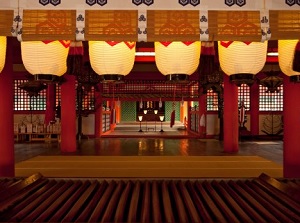
Inside of main shrine
Photo : Hiroshima Prefectural Tourism Federation
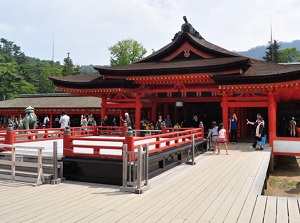
Stage in front of main shrine
Photo by Railstation.net
The bottom of the cove appears at low tide, so we can reach Ôtorii on foot at that time.
After the tide comes in, all buildings are on the sea.
It's surprising that the people in the 12th century constructed such unique and adventurous buildings.
Of course, because this wooden shrine is on the sea, it is prone to natural disasters such as typhoon, high tide.
Whenever this shrine suffered from such disasters, many people believing this shrine have repaired and restored.
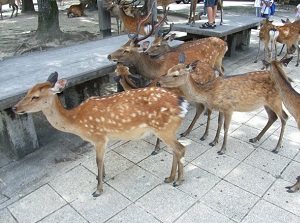
Deer on the approach to Itsukushima Shrine
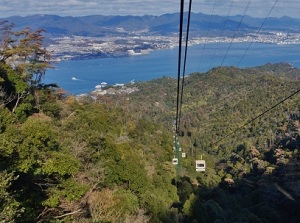
Ropeway to Mount Misen
We can visit this island by ferry from mainland.
From the pier to the entrance of the shrine, there is the approach about 800 meters long along the coast.
Around the approach, there are many souvenir shops.
By the way, there are several deer on the approach and around the shrine.
But, in Miyajima, it is prohibited to give food to the deer.
Even the foods for deer are not sold.
Because, all deer are wild and have been living in the island.
Deer is the messenger of a god in Nara city, but deer in Miyajima is not so.
Therefore, visitors should keep away from the deer.
About 5 km south of the shrine, there is Mount Misen (弥山, 535 m).
We can visit near the top of the mountain by ropeway.
Itsukushima Shrine and the old growth forests around Mount Misen are designated as a World Heritage Site.
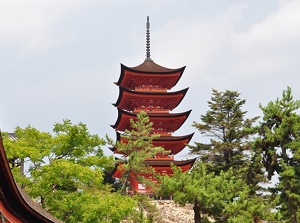
Five-story Pagoda of Senjokaku
Photo by Railstation.net
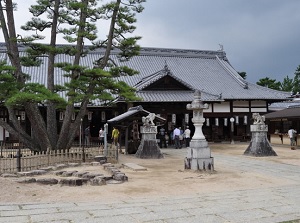
Main temple of Daiganji
Photo by Railstation.net
In this island, there is only an old town around Itsukushima Shrine.
Because this island is the sacred land since ancient times, so it differs from the common town.
There is no tomb.
Because, "death" is a taboo word in front of gods.
There is no farm land.
Because, cultivating the sacred land is also a taboo.
There are a few buildings belonging to Itsukushima Shrine.
Senjôkaku (千畳閣) is a shrine just to the north of Itsukushima Shrine.
Toyotomi Hideyoshi who united Japan ordered to built as a Buddhist temple in 1587, but the construction was stopped in 1598 because of his death.
In 1872, the temple became a subsidiary shrine of Itsukushima Shrine.
There are a main hall and Five-story Pagoda built in 1407 in the precinct.
In the town, there are several Buddhist temples.
Daisho-in (大聖院) founded in 806 and Daiganji (大願寺) rebuilt in the 1200s are the main temples.
How to get here
By local train of JR San-yo Line, about 25 minutes from Hiroshima to Miyajima-guchi.
Or, by street car of Hiroshima-Dentetsu Line (Hiroden), about 1 hour from central Hiroshima to Hiroden-Miyajima terminal station.
Then, by ferry, about 10 minutes from Miyajima-guchi to Miyajima.
From each railroad station to the pier, a few minutes walk.
The ferry is operated frequently.
Two companies, JR West and Miyajima Matsudai Kisen, operate the ferry.
Japan Rail Pass is available for JR West Ferry.
Ropeway to Mt.Misen starts from Momijidani Park on the side of the mountain, and two routes are connected.

